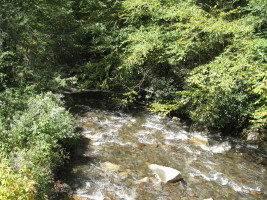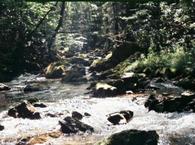Big Snowbird Creek lies in the southwestern portion of North Carolina with its headwaters located in the Snowbird Mountains in Graham County. From the headwaters, Big Snowbird Creek flows through a rugged portion of the Nantahala National Forest and over three very scenic waterfalls before it empties into the Santeetlah Lake, not far from Robbinsville.
Big Snowbird Road (SR 1120) follows Big Snowbird Creek for several miles to an old railroad turnaround where it ends and becomes a parking area known as the “Junction”. Further access to the stream can be fairly easy from the well maintained Big Snowbird Creek Trail however there some portions of the trail that are high above Big Snowbird Creek. After reaching the stream, anglers may want to wade up it to avoid the heavy concentration of rhododendrons. Due to the ease of access, fishing pressure can be somewhat heavy on Big Snowbird Creek in spring and early summer.
Big Snowbird Creek has three different characteristics that provide the angler ample opportunity to catch a rainbow, a brown and a brookie all in one day. This is known in the mountains as the “grand slam”.
To do this on Big Snowbird Creek, the angler can start at the lower end near the confluence with SanteetlahLake and work his way up to the Junction. This section is hatchery supported with both rainbow and brown trout. Some of the deeper pools found in this lower section are capable of giving up some brown trout in the 18 to 20 inch size. Score one for browns.
Between the Junction and the headwaters of Big Snowbird Creek for a distance of approximately 12 miles, accessed only by foot, the trout are wild as there are no stocking activities. Included in this portion is about a 5 mile section of wide open waters containing a good population of trout consisting primarily of rainbows. Large boulders provide fast water runs and deeper pools that rainbows prefer providing an excellent opportunity for the fly fishing angler to score one for rainbows.
The 7 miles stretch of the Big Snowbird Creek starting at the Lower Falls and continuing to the headwaters provides the angler his opportunity to catch a brookie that can be as large as 12 inches. There are several tributaries in this area that support good populations of brook trout as well.
Some interesting history took place here in the snowbird Mountains. The grave of Chief Junaluska, is the nearby town of Robbinsville, NC. He is the Cherokee chief who saved the life of Andrew Jackson in the 1814 Battle of Horseshoe.
Fishing the Big Snowbird Creek:
Use a three or four weight rod, with a floating line, and a 10 or 12 foot leader finished off with a 6X or 7X tippet as a compromise to the variety of fishing conditions you will experience on the Big Snowbird Creek. The food available for the trout consists of mayflies, caddis flies and midges so these are the flies that you should be prepared to imitate.
If you are wading be careful as the stream bed can be very slippery. Despite the fact that I was wearing felt soled boots, I fell with my very first step into the Big Snowbird Creek so I would be remiss if I did not post this warning.
Late winter and spring:
On the Big Snowbird Creek in late winter and spring, the best part of the day will be from noon to dusk with the late afternoon affording the optimum conditions. The aquatic insect population is much the same as Slickrock Creek so start with the midges in late winter followed by the blue winged olives, quill gordons or other mayflies, as well as the caddis flies. Later in mid April start with the light cahills and stoneflies using a 12 or 14 hook size if the water remains high. A roll cast will be effective in getting good placement and try to avoid the drag or any type of unnatural drift. In higher elevations the Yallarhammer will work well but with brookies the pattern is not as important as the presentation.
Summer:
The fishing remains good in the summer, especially in the low light conditions of the mornings and the late evenings. The terrestrials will be effective for the brookies, and the nymphs will be more effective in the lower elevations for the browns. Cast your size 18 or 20 nymph fly into the shady areas or pocket waters and it may be useful to try a tandem rig with a dry fly as an attractant. Again, avoid an unnatural drift.
Fall:
You can expect to see less traffic on the Big Snowbird Creek during the fall and the fishing remains fairly good. It is a good time for the ant, grasshopper and beetle imitations. Blue winged olives and midges are good patterns for this season and the scenery will make your trip memorable.






